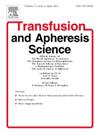Precision diagnostics in Transfusion Medicine: Advancing accuracy in Bombay blood group typing through molecular methods
IF 1.4
4区 医学
Q4 HEMATOLOGY
引用次数: 0
Abstract
Background
Integration of precision diagnosis in Immunohaematology and Transfusion Medicine has led to the development of more refined blood typing and crossmatching techniques, ensuring improved accuracy of blood group determination, thereby reducing the incidence of transfusion reactions and enhancing patient safety. It can also help resolve complex discrepancies noted in serological testing methods.
Study design and methods
The blood grouping of a 40 year old female patient done as a part of routine health check using column agglutination technology showed a O group phenotype with additional reaction with O cells in the serum group. Anti-H lectin study confirmed the absence of H antigen, with a Lewis Le(a+b-) phenotype, typing the patient as Classical Bombay phenotype. Further molecular workup was performed.
Results
An in-house designed panel enabling comprehensive genotyping for 45 blood group systems and transcription factors KLF1 and GATA1 was used. Sequencing covering the ABO gene predicted the presence of the ABO*O.01.01 and ABO*O.01.02 alleles and the group O phenotype. Combined results of the sequencing analysis identified ABO*O.01.01/*O.01.02, FUT1*01N.09/*01N.09 and FUT2*01/*01 with the predicted phenotype of H-deficient; secretor (para-Bombay). Oh-secretor shows the patient is genetically a ParaBombay since there is an active secretor gene, but phenotyped as Le(a+b-) due to the reduction in Lewis enzyme function by the FUT3 mutations. Hence the patient is classified as a paraBombay, even though the Lewis phenotype make the patient appeared to be a classical Bombay.
Conclusion
Integration of precision diagnostics into transfusion therapy improves transplant and transfusion safety.
输血医学中的精确诊断:通过分子方法提高孟买血型分型的准确性
免疫血液学和输血医学中精确诊断的整合导致了更精细的血型和交叉配型技术的发展,确保了血型测定的准确性,从而减少了输血反应的发生,提高了患者的安全性。它还可以帮助解决血清学检测方法中出现的复杂差异。研究设计与方法对40岁女性患者进行常规健康检查,采用柱凝集技术对其进行血型分析,结果显示为O型表型,血清组与O细胞有附加反应。抗H凝集素研究证实H抗原缺失,具有Lewis Le(a+b-)表型,分型为经典孟买表型。进行了进一步的分子检查。结果采用内部设计的面板,对45种血型系统和转录因子KLF1和GATA1进行综合基因分型。覆盖ABO基因的测序预测ABO*O.01.01和ABO*O.01.02等位基因和O组表型的存在。综合测序分析结果,ABO*O.01.01/*O.01.02, FUT1*01N.09/*01N。09和FUT2*01/*01与预测h缺陷表型一致;分泌腺(para-Bombay)。Oh-secretor表明患者在基因上是ParaBombay,因为有一个活跃的分泌基因,但由于FUT3突变导致Lewis酶功能降低,表型为Le(a+b-)。因此,患者被归类为准孟买人,尽管刘易斯表型使患者看起来是典型的孟买人。结论精准诊断与输血治疗相结合,提高了移植和输血的安全性。
本文章由计算机程序翻译,如有差异,请以英文原文为准。
求助全文
约1分钟内获得全文
求助全文
来源期刊
CiteScore
3.60
自引率
5.30%
发文量
181
审稿时长
42 days
期刊介绍:
Transfusion and Apheresis Science brings comprehensive and up-to-date information to physicians and health care professionals involved in the rapidly changing fields of transfusion medicine, hemostasis and apheresis. The journal presents original articles relating to scientific and clinical studies in the areas of immunohematology, transfusion practice, bleeding and thrombotic disorders and both therapeutic and donor apheresis including hematopoietic stem cells. Topics covered include the collection and processing of blood, compatibility testing and guidelines for the use of blood products, as well as screening for and transmission of blood-borne diseases. All areas of apheresis - therapeutic and collection - are also addressed. We would like to specifically encourage allied health professionals in this area to submit manuscripts that relate to improved patient and donor care, technical aspects and educational issues.
Transfusion and Apheresis Science features a "Theme" section which includes, in each issue, a group of papers designed to review a specific topic of current importance in transfusion and hemostasis for the discussion of topical issues specific to apheresis and focuses on the operators'' viewpoint. Another section is "What''s Happening" which provides informal reporting of activities in the field. In addition, brief case reports and Letters to the Editor, as well as reviews of meetings and events of general interest, and a listing of recent patents make the journal a complete source of information for practitioners of transfusion, hemostasis and apheresis science. Immediate dissemination of important information is ensured by the commitment of Transfusion and Apheresis Science to rapid publication of both symposia and submitted papers.

 求助内容:
求助内容: 应助结果提醒方式:
应助结果提醒方式:


